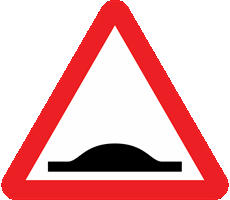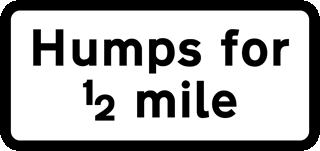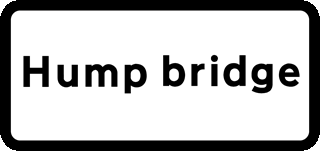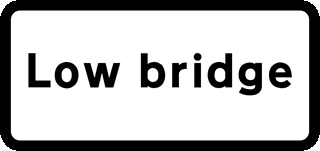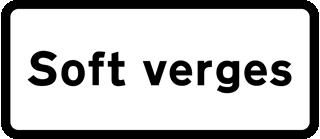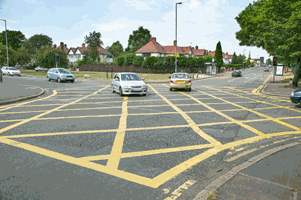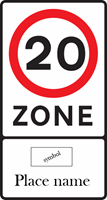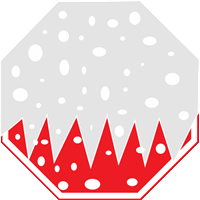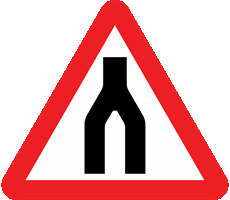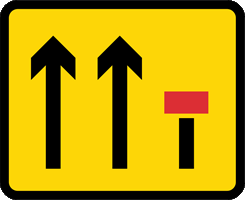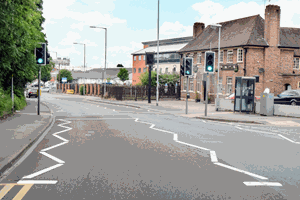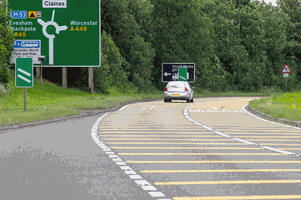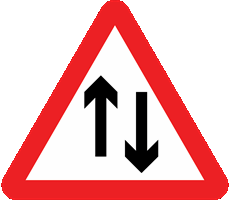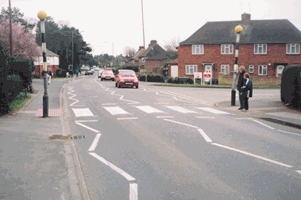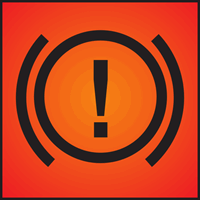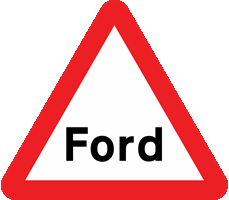You have 57 minutes to answer 50 multiple choice driving theory test questions. You need to answer at least 43 out of 50 questions correctly to pass. You can review your answer after each question or you can review all of your answers at the end of the test. Best of luck!
Test Quick View
Click on an answer to view the correct choice along with the explanation.
Correct Answer: C
Explanation: The car arrowed A is parked within the area marked by zigzag lines at the pedestrian crossing. Parking here is illegal. It also
- blocks the view for pedestrians wishing to cross the road
- restricts the view of the crossing for approaching traffic
Explanation: The car arrowed A is parked within the area marked by zigzag lines at the pedestrian crossing. Parking here is illegal. It also
- blocks the view for pedestrians wishing to cross the road
- restricts the view of the crossing for approaching traffic
2. You're unsure what a slow-moving motorcyclist ahead of you is going to do. What should you do?
Mark one answer
B
C
D
Correct Answer: D
Explanation: When a motorcyclist is travelling slowly, it's likely that they're looking for a turning or entrance. Be patient and stay behind them in case they stop or change direction suddenly.
Explanation: When a motorcyclist is travelling slowly, it's likely that they're looking for a turning or entrance. Be patient and stay behind them in case they stop or change direction suddenly.
Correct Answer: A
Explanation: Road humps are used to slow down traffic.They're found in places where there are often pedestrians, such as
- shopping areas
- near schools
- residential areas.
Watch out for people close to the kerb or crossing the road.
Explanation: Road humps are used to slow down traffic.They're found in places where there are often pedestrians, such as
- shopping areas
- near schools
- residential areas.
Watch out for people close to the kerb or crossing the road.
Correct Answer: D
Explanation: Yellow box junctions are marked on the road to prevent the road becoming blocked. Don't enter the box unless your exit road is clear. You may wait in the box if you want to turn right and your exit road is clear but oncoming traffic or other vehicles waiting to turn right are preventing you from making the turn.
Explanation: Yellow box junctions are marked on the road to prevent the road becoming blocked. Don't enter the box unless your exit road is clear. You may wait in the box if you want to turn right and your exit road is clear but oncoming traffic or other vehicles waiting to turn right are preventing you from making the turn.
Correct Answer: B
Explanation: If you're in a place where there are likely to be pedestrians (for example, outside a school, near a park, in a residential area or in a shopping area), you should be cautious and keep your speed down. Many local authorities have taken steps to slow traffic down by creating traffic-calming measures such as speed humps. They're there for a reason; slow down.
Explanation: If you're in a place where there are likely to be pedestrians (for example, outside a school, near a park, in a residential area or in a shopping area), you should be cautious and keep your speed down. Many local authorities have taken steps to slow traffic down by creating traffic-calming measures such as speed humps. They're there for a reason; slow down.
Correct Answer: C
Explanation: A sign will indicate which types of vehicles are prohibited from certain roads. Make sure that you know which signs apply to the vehicle you're using.
Explanation: A sign will indicate which types of vehicles are prohibited from certain roads. Make sure that you know which signs apply to the vehicle you're using.
Correct Answer: C
Explanation: The 'stop' sign is the only road sign that's octagonal. This is so that it can be recognised and obeyed even if it's obscured (for example, by snow).
Explanation: The 'stop' sign is the only road sign that's octagonal. This is so that it can be recognised and obeyed even if it's obscured (for example, by snow).
Correct Answer: A
Explanation: Don't wait until the last moment before moving into the left-hand lane. Plan ahead and don't rely on other traffic letting you in.
Explanation: Don't wait until the last moment before moving into the left-hand lane. Plan ahead and don't rely on other traffic letting you in.
Correct Answer: D
Explanation: Yellow-and-black temporary signs may be used to inform you about roadworks or lane restrictions. Look well ahead. If you have to change lanes, do so in good time.
Explanation: Yellow-and-black temporary signs may be used to inform you about roadworks or lane restrictions. Look well ahead. If you have to change lanes, do so in good time.
Correct Answer: A
Explanation: The approach to, and exit from, a pedestrian crossing is marked with zigzag lines. You mustn't park on them or overtake the leading vehicle when approaching the crossing. Parking here would block the view for pedestrians and approaching traffic.
Explanation: The approach to, and exit from, a pedestrian crossing is marked with zigzag lines. You mustn't park on them or overtake the leading vehicle when approaching the crossing. Parking here would block the view for pedestrians and approaching traffic.
Correct Answer: C
Explanation: Catalytic converters reduce a large percentage of harmful exhaust emissions. They work more efficiently when the engine has reached its normal working temperature.
Explanation: Catalytic converters reduce a large percentage of harmful exhaust emissions. They work more efficiently when the engine has reached its normal working temperature.
12. What should you do when you're following a learner driver who stalls at a junction?
Mark one answer
B
C
D
Correct Answer: A
Explanation: Learning to drive is a process of practice and experience. Try to understand this and tolerate those who make mistakes while they're learning.
Explanation: Learning to drive is a process of practice and experience. Try to understand this and tolerate those who make mistakes while they're learning.
Correct Answer: D
Explanation: Never sound the horn aggressively. You mustn't sound it when driving in a built-up area between 11.30 pm and 7.00 am, or when you're stationary, unless another road user poses a danger. Don't scare animals by sounding your horn.
Explanation: Never sound the horn aggressively. You mustn't sound it when driving in a built-up area between 11.30 pm and 7.00 am, or when you're stationary, unless another road user poses a danger. Don't scare animals by sounding your horn.
Correct Answer: D
Explanation: Batteries contain acid, which is hazardous, and they must be disposed of safely. This means taking them to an appropriate disposal site.
Explanation: Batteries contain acid, which is hazardous, and they must be disposed of safely. This means taking them to an appropriate disposal site.
Correct Answer: B
Explanation: These lines may be painted on the road on the approach to a roundabout, a village or a particular hazard. The lines are raised and painted yellow, and their purpose is to make you aware of your speed. Reduce your speed in good time so that you avoid having to brake harshly over the last few metres before reaching the junction.
Explanation: These lines may be painted on the road on the approach to a roundabout, a village or a particular hazard. The lines are raised and painted yellow, and their purpose is to make you aware of your speed. Reduce your speed in good time so that you avoid having to brake harshly over the last few metres before reaching the junction.
16. What's the reason for the area marked in red and white along the centre of this road?
Mark one answer
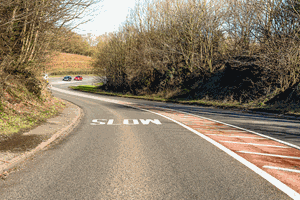
B
C
D
Correct Answer: C
Explanation: Areas of 'hatched markings' such as these separate traffic streams that could be a danger to each other. They're often seen on bends or where the road becomes narrow. If the area is bordered by a solid white line, you mustn't enter it except in an emergency.
Explanation: Areas of 'hatched markings' such as these separate traffic streams that could be a danger to each other. They're often seen on bends or where the road becomes narrow. If the area is bordered by a solid white line, you mustn't enter it except in an emergency.
17. What must you do when entering roadworks where a temporary speed limit is displayed?
Mark one answer
B
C
D
Correct Answer: C
Explanation: Where there are extra hazards, such as at roadworks, it's often necessary to slow traffic down by imposing a lower speed limit. These speed limits aren't advisory; they must be obeyed.
Explanation: Where there are extra hazards, such as at roadworks, it's often necessary to slow traffic down by imposing a lower speed limit. These speed limits aren't advisory; they must be obeyed.
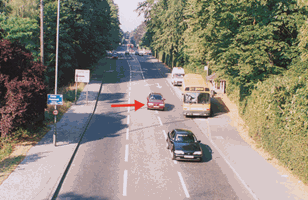
B
C
D
Correct Answer: D
Explanation: If you can do so safely, give way to buses signalling to move off at bus stops. Try to anticipate the actions of other road users around you. The driver of the red car should be prepared for the bus pulling out. As you approach a bus stop, look to see how many passengers are waiting to board. If the last one has just got on, the bus is likely to move off.
Explanation: If you can do so safely, give way to buses signalling to move off at bus stops. Try to anticipate the actions of other road users around you. The driver of the red car should be prepared for the bus pulling out. As you approach a bus stop, look to see how many passengers are waiting to board. If the last one has just got on, the bus is likely to move off.
Correct Answer: B
Explanation: You'll see this sign if there has been an incident ahead and the motorway is closed. You must obey the sign. Make sure that you prepare to leave in good time. Don't cause drivers to take avoiding action by cutting in at the last moment.
Explanation: You'll see this sign if there has been an incident ahead and the motorway is closed. You must obey the sign. Make sure that you prepare to leave in good time. Don't cause drivers to take avoiding action by cutting in at the last moment.
Correct Answer: D
Explanation: This sign may be at the end of a dual carriageway or a one-way street. It's there to warn you of oncoming traffic.
Explanation: This sign may be at the end of a dual carriageway or a one-way street. It's there to warn you of oncoming traffic.
21. You're on a motorway. A red cross is displayed above the hard shoulder. What does this mean?
Mark one answer
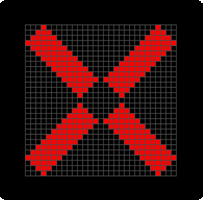
B
C
D
Correct Answer: D
Explanation: Active traffic management operates on some motorways. Within these areas, at certain times, the hard shoulder will be used as a running lane. A red cross above the hard shoulder shows that this lane should only be used for emergencies and breakdowns.
Explanation: Active traffic management operates on some motorways. Within these areas, at certain times, the hard shoulder will be used as a running lane. A red cross above the hard shoulder shows that this lane should only be used for emergencies and breakdowns.
22. You're on a smart motorway. A mandatory speed limit is displayed above the hard shoulder. What does this mean?
Mark one answer
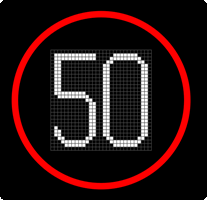
B
C
D
Correct Answer: A
Explanation: A mandatory speed-limit sign above the hard shoulder shows that this part of the road can be used as a running lane between junctions. You must stay within the speed limit. Look out for vehicles that may have broken down and could be blocking the hard shoulder.
Explanation: A mandatory speed-limit sign above the hard shoulder shows that this part of the road can be used as a running lane between junctions. You must stay within the speed limit. Look out for vehicles that may have broken down and could be blocking the hard shoulder.
Correct Answer: C
Explanation: You should be constantly scanning the road for clues about what's going to happen next. Check your mirrors regularly, particularly as soon as you spot a hazard. What's happening behind may affect your response to hazards ahead.
Explanation: You should be constantly scanning the road for clues about what's going to happen next. Check your mirrors regularly, particularly as soon as you spot a hazard. What's happening behind may affect your response to hazards ahead.
Correct Answer: A
Explanation: Using the controls smoothly can reduce fuel consumption by about 15%, as well as reducing wear and tear on your vehicle. Plan ahead and anticipate changes of speed well in advance. This will reduce the need to accelerate rapidly or brake sharply.
Explanation: Using the controls smoothly can reduce fuel consumption by about 15%, as well as reducing wear and tear on your vehicle. Plan ahead and anticipate changes of speed well in advance. This will reduce the need to accelerate rapidly or brake sharply.
Correct Answer: B
Explanation: Be courteous and prepare to stop. Don't wave people across, because this could be dangerous if another vehicle is approaching the crossing.
Explanation: Be courteous and prepare to stop. Don't wave people across, because this could be dangerous if another vehicle is approaching the crossing.
26. An injured motorcyclist is lying unconscious in the road. The traffic has stopped and there's no further danger. What should you do to help?
Mark one answer
B
C
D
Correct Answer: D
Explanation: If someone has been injured, the sooner proper medical attention is given the better. Ask someone to phone for help or do it yourself. An injured person should only be moved if they're in further danger. An injured motorcyclist's helmet shouldn't be removed unless it's essential.
Explanation: If someone has been injured, the sooner proper medical attention is given the better. Ask someone to phone for help or do it yourself. An injured person should only be moved if they're in further danger. An injured motorcyclist's helmet shouldn't be removed unless it's essential.
Correct Answer: A
Explanation: If you're the first to arrive at a crash scene the first concerns are the risk of further collision and fire. Ensuring that vehicle engines are switched off will reduce the risk of fire. Use hazard warning lights so that other traffic knows there's a need for caution. Make sure the emergency services are contacted, don't assume this has already been done.
Explanation: If you're the first to arrive at a crash scene the first concerns are the risk of further collision and fire. Ensuring that vehicle engines are switched off will reduce the risk of fire. Use hazard warning lights so that other traffic knows there's a need for caution. Make sure the emergency services are contacted, don't assume this has already been done.
Correct Answer: C
Explanation: Ensure that you can see clearly through the windscreen of your vehicle. Stickers or hanging objects could obstruct your view or draw your attention away from the road.
Explanation: Ensure that you can see clearly through the windscreen of your vehicle. Stickers or hanging objects could obstruct your view or draw your attention away from the road.
Correct Answer: A
Explanation: If this light comes on, you should have the brake system checked immediately. A faulty braking system could have dangerous consequences.
Explanation: If this light comes on, you should have the brake system checked immediately. A faulty braking system could have dangerous consequences.
Correct Answer: C
Explanation: In snowy conditions, be careful with the steering, accelerator and brakes. Braking sharply while you're driving on snow is likely to make your car skid.
Explanation: In snowy conditions, be careful with the steering, accelerator and brakes. Braking sharply while you're driving on snow is likely to make your car skid.
31. What advice should you give to a driver who has had a few alcoholic drinks at a party?
Mark one answer
B
C
D
Correct Answer: B
Explanation: Drinking black coffee or waiting a few hours won't make any difference. Alcohol takes time to leave the body. A driver who has been drinking should go home by public transport or taxi. They might even be unfit to drive the following morning.
Explanation: Drinking black coffee or waiting a few hours won't make any difference. Alcohol takes time to leave the body. A driver who has been drinking should go home by public transport or taxi. They might even be unfit to drive the following morning.
32. During periods of illness, your ability to drive may be impaired. What must you do?
Mark one answer
B
C
D
Correct Answer: A
Explanation: Only drive if you're fit to do so. Driving when you're ill or taking some medicines can affect your concentration and judgement. It may also cause you to become drowsy or even fall asleep.
Explanation: Only drive if you're fit to do so. Driving when you're ill or taking some medicines can affect your concentration and judgement. It may also cause you to become drowsy or even fall asleep.
33. You want to turn right from a main road into a side road. What should you do just before turning?
Mark one answer
B
C
D
Correct Answer: B
Explanation: In some circumstances, your indicators may be difficult to see and another road user may not realise you're about to turn. A final check in your mirror and blind spot can help you to see an overtaking vehicle, so that you can avoid turning across their path.
Explanation: In some circumstances, your indicators may be difficult to see and another road user may not realise you're about to turn. A final check in your mirror and blind spot can help you to see an overtaking vehicle, so that you can avoid turning across their path.
34. A single carriageway road has this sign. What's the maximum permitted speed for a car towing a trailer?
Mark one answer
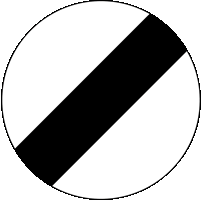
B
C
D
Correct Answer: C
Explanation: When you're towing a trailer, a reduced speed limit also applies on dual carriageways and motorways. These lower speed limits apply to vehicles pulling all sorts of trailers, including caravans and horse boxes.
Explanation: When you're towing a trailer, a reduced speed limit also applies on dual carriageways and motorways. These lower speed limits apply to vehicles pulling all sorts of trailers, including caravans and horse boxes.
Correct Answer: A
Explanation: Rear fog lights shine more brightly than normal rear lights, so that they show up in reduced visibility. When the visibility improves, you must switch them off; this stops them dazzling the driver behind.
Explanation: Rear fog lights shine more brightly than normal rear lights, so that they show up in reduced visibility. When the visibility improves, you must switch them off; this stops them dazzling the driver behind.
36. You're driving on a wet road. You have to stop your vehicle in an emergency. What should you do?
Mark one answer
B
C
D
Correct Answer: C
Explanation: As you drive, look well ahead and all around so that you're ready for any hazards that might develop. If you have to stop in an emergency, react as soon as you can while keeping control of the vehicle. Keep both hands on the steering wheel so you can control the vehicle's direction of travel.
Explanation: As you drive, look well ahead and all around so that you're ready for any hazards that might develop. If you have to stop in an emergency, react as soon as you can while keeping control of the vehicle. Keep both hands on the steering wheel so you can control the vehicle's direction of travel.
Correct Answer: C
Explanation: If your wheels are out of balance, it will cause the steering to vibrate at certain speeds. This isn't a fault that will put itself right, so take your vehicle to a garage or tyre fitter to have the wheels rebalanced.
Explanation: If your wheels are out of balance, it will cause the steering to vibrate at certain speeds. This isn't a fault that will put itself right, so take your vehicle to a garage or tyre fitter to have the wheels rebalanced.
Correct Answer: D
Explanation: The registered keeper of the vehicle is responsible for paying the vehicle excise duty or making a Statutory Off-Road Notification (SORN) if the vehicle is to be kept untaxed and off the road.
Explanation: The registered keeper of the vehicle is responsible for paying the vehicle excise duty or making a Statutory Off-Road Notification (SORN) if the vehicle is to be kept untaxed and off the road.
B
C
D
Correct Answer: A
Explanation: Talking to someone while you're driving can distract you and, unlike someone in the car with you, the person on the other end of a mobile phone is unable to see the traffic situations you're dealing with. They won't stop speaking to you even if you're approaching a hazardous situation. You need to concentrate on your driving all of the time, but especially so when dealing with a hazard.
Explanation: Talking to someone while you're driving can distract you and, unlike someone in the car with you, the person on the other end of a mobile phone is unable to see the traffic situations you're dealing with. They won't stop speaking to you even if you're approaching a hazardous situation. You need to concentrate on your driving all of the time, but especially so when dealing with a hazard.
Correct Answer: B
Explanation: Having your vehicle broken into or stolen can be very distressing and inconvenient. Avoid leaving your vehicle unattended in poorly-lit areas.
Explanation: Having your vehicle broken into or stolen can be very distressing and inconvenient. Avoid leaving your vehicle unattended in poorly-lit areas.
Correct Answer: B
Explanation: When driving on downhill stretches of road, selecting a lower gear gives increased engine braking. This will prevent excessive use of the brakes, which become less effective if they overheat.
Explanation: When driving on downhill stretches of road, selecting a lower gear gives increased engine braking. This will prevent excessive use of the brakes, which become less effective if they overheat.
Correct Answer: A
Explanation: If your car is fitted with anti-lock brakes, they'll only activate when they sense that the wheels are about to lock. By preventing the wheels from locking, you'll be able to steer to avoid the hazard, while maximum braking is also applied.
Explanation: If your car is fitted with anti-lock brakes, they'll only activate when they sense that the wheels are about to lock. By preventing the wheels from locking, you'll be able to steer to avoid the hazard, while maximum braking is also applied.
43. You're driving in heavy traffic on a wet road. Spray makes it difficult to be seen. What lights should you use?
Mark one answer
B
C
D
Correct Answer: A
Explanation: You must make sure that other road users can see you, but you don't want to dazzle them. Use your dipped headlights during the day if visibility is poor. If visibility falls below 100 metres (328 feet), you may use your rear fog lights, but don't forget to turn them off when the visibility improves.
Explanation: You must make sure that other road users can see you, but you don't want to dazzle them. Use your dipped headlights during the day if visibility is poor. If visibility falls below 100 metres (328 feet), you may use your rear fog lights, but don't forget to turn them off when the visibility improves.
Correct Answer: B
Explanation: Learner drivers benefit by combining professional driving lessons with private practice. However, you need to be at least 21 years old and have held your driving licence for at least 3 years before you can supervise a learner driver.
Explanation: Learner drivers benefit by combining professional driving lessons with private practice. However, you need to be at least 21 years old and have held your driving licence for at least 3 years before you can supervise a learner driver.
Correct Answer: D
Explanation: In normal conditions, a ford can be crossed quite safely by driving through it slowly. The water may affect your brakes, so when you're clear of the ford, test them before you resume normal driving.
Explanation: In normal conditions, a ford can be crossed quite safely by driving through it slowly. The water may affect your brakes, so when you're clear of the ford, test them before you resume normal driving.
B
C
D
Correct Answer: D
Explanation: You must be completely sure it's safe to emerge. Try to look for traffic through the windows of the parked cars or in the reflections in shop windows. Keep looking in all directions as you slowly edge forwards until you can see it's safe.
Explanation: You must be completely sure it's safe to emerge. Try to look for traffic through the windows of the parked cars or in the reflections in shop windows. Keep looking in all directions as you slowly edge forwards until you can see it's safe.
Correct Answer: D
Explanation: Too much oil in the engine will create excess pressure and could damage engine seals and cause oil leaks. Any excess oil should be drained off.
Explanation: Too much oil in the engine will create excess pressure and could damage engine seals and cause oil leaks. Any excess oil should be drained off.
Correct Answer: D
Explanation: The Pass Plus scheme was created for newly qualified drivers. It aims to widen their driving experience and improve basic skills. After passing the practical driving test, additional professional training can be taken with an approved driving instructor (ADI). Some insurance companies also offer discounts to holders of a Pass Plus certificate.
Explanation: The Pass Plus scheme was created for newly qualified drivers. It aims to widen their driving experience and improve basic skills. After passing the practical driving test, additional professional training can be taken with an approved driving instructor (ADI). Some insurance companies also offer discounts to holders of a Pass Plus certificate.
Correct Answer: D
Explanation: Usually, a correct child restraint must be used. In cases where one isn't available, an adult seat belt must be used instead. In a collision, unrestrained objects and people can cause serious injury or even death.
Explanation: Usually, a correct child restraint must be used. In cases where one isn't available, an adult seat belt must be used instead. In a collision, unrestrained objects and people can cause serious injury or even death.
50. You're in collision with another moving vehicle. Someone is injured and your vehicle is damaged. What information should you find out?
Mark one answer
B
C
D
Correct Answer: C
Explanation: Try to keep calm and don't rush. Make sure that you've shared all the relevant details with the other driver before you leave the scene. If possible, take pictures and note the positions of all the vehicles involved.
Explanation: Try to keep calm and don't rush. Make sure that you've shared all the relevant details with the other driver before you leave the scene. If possible, take pictures and note the positions of all the vehicles involved.




